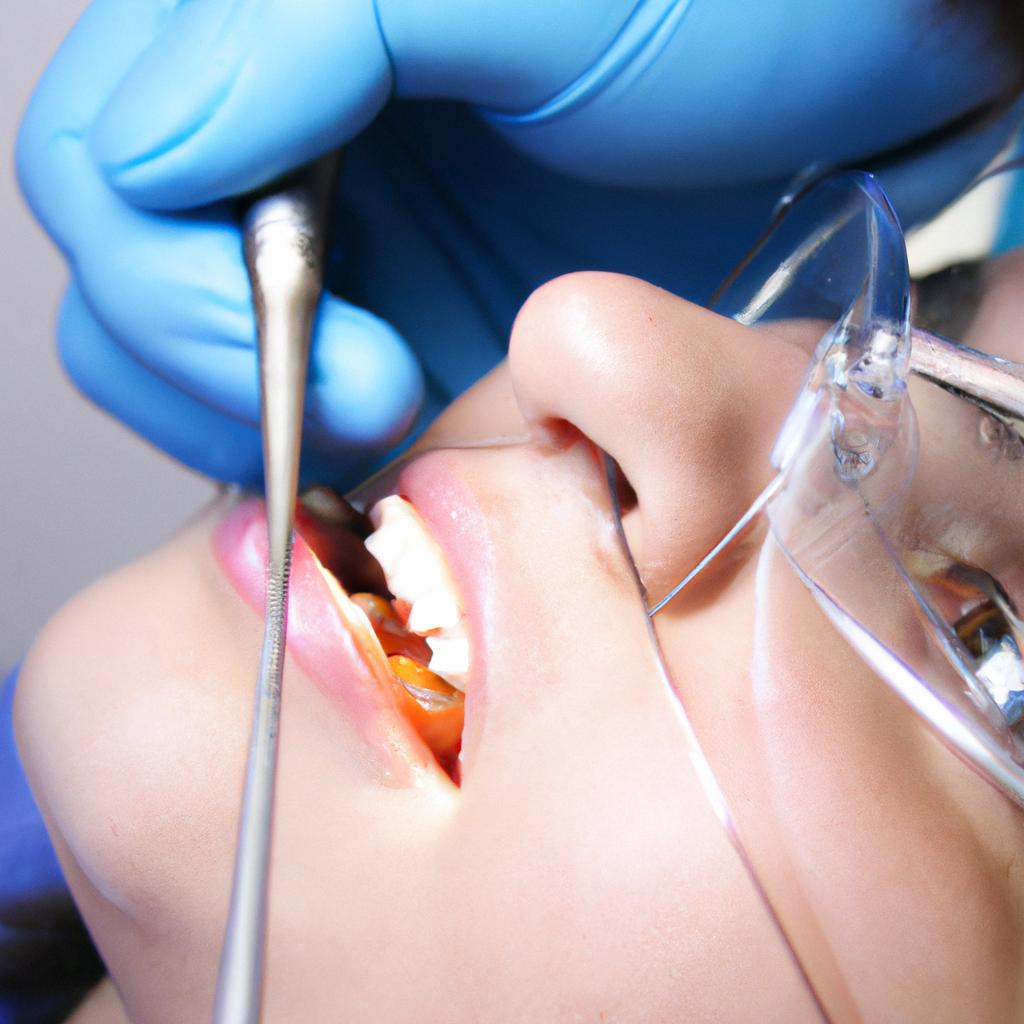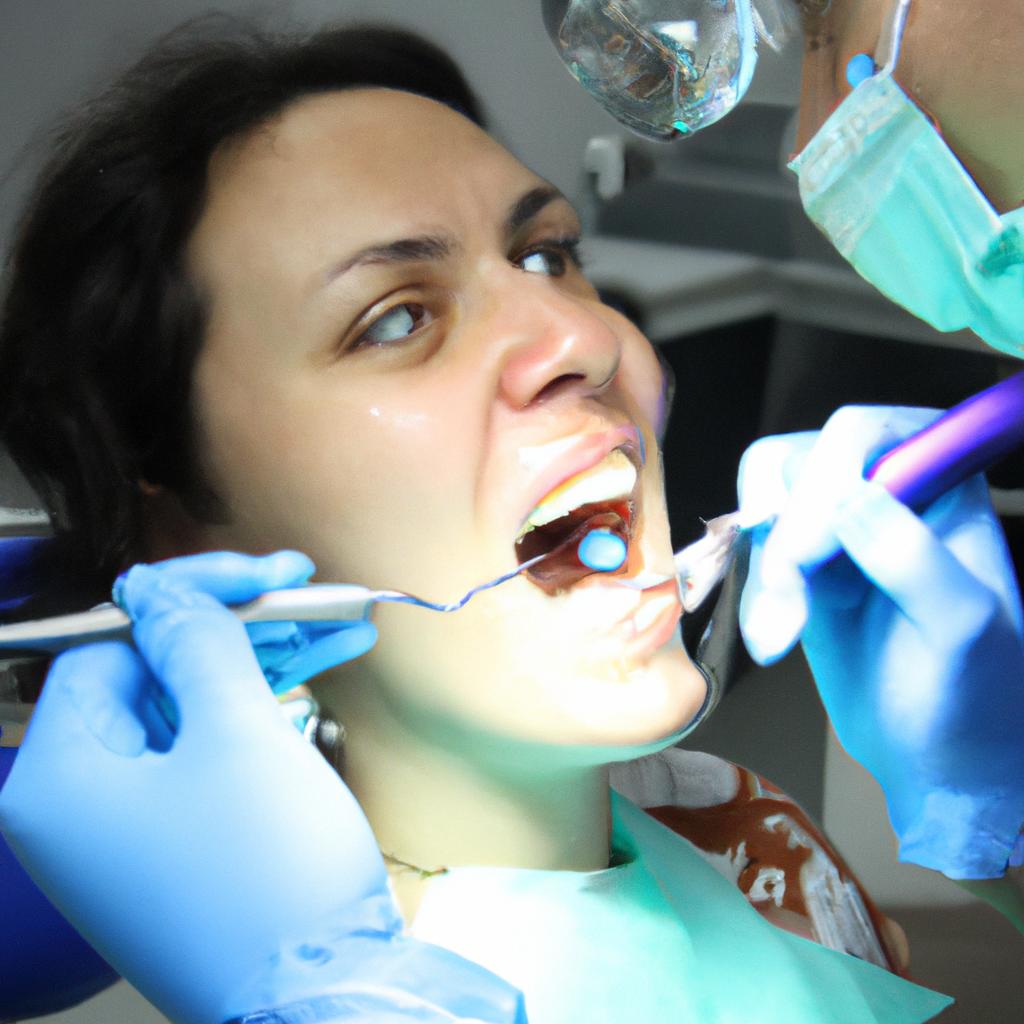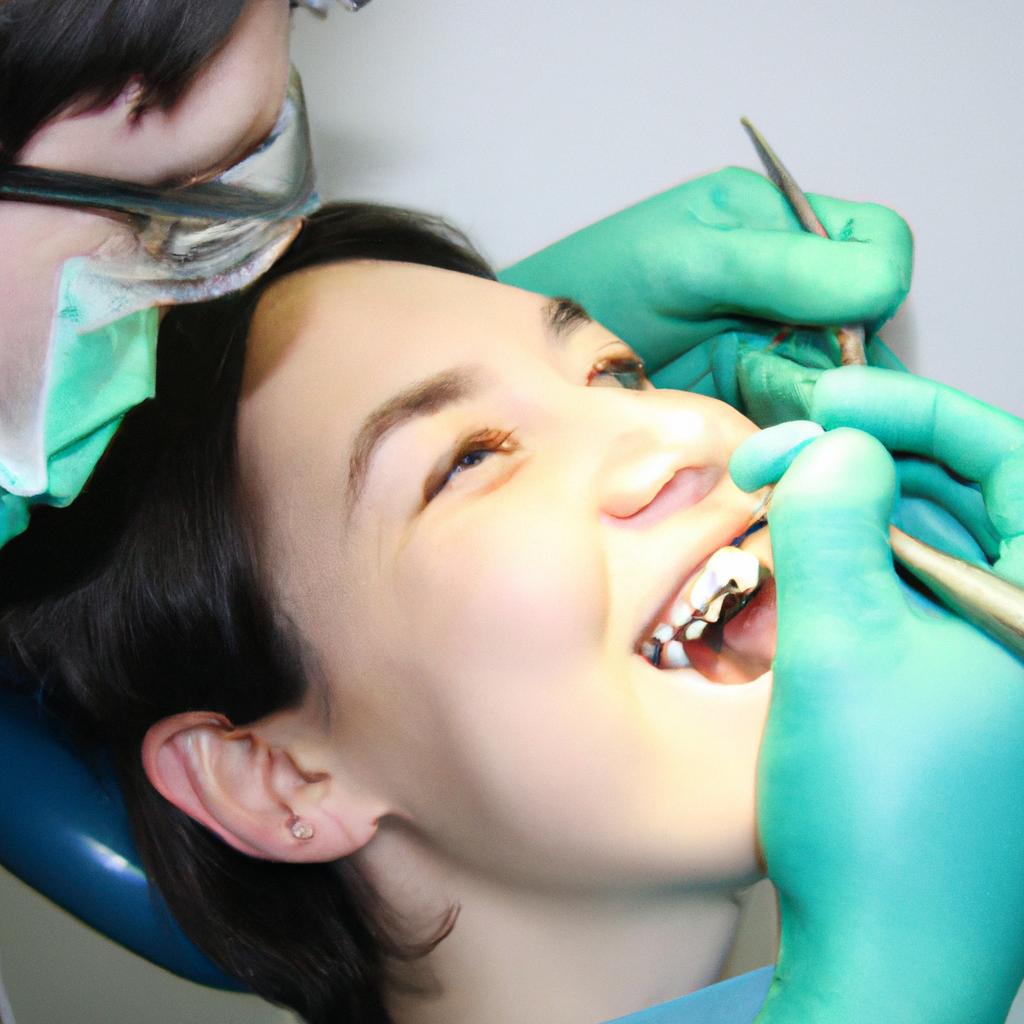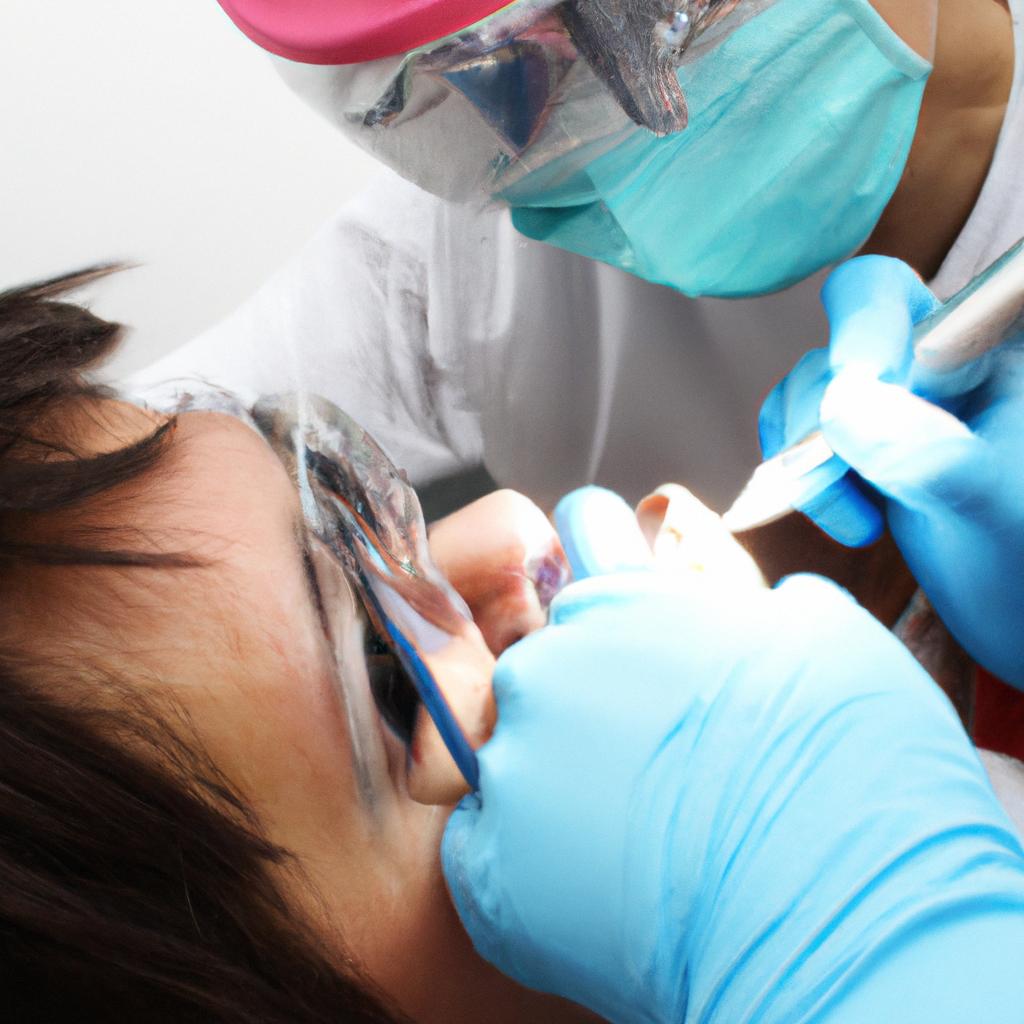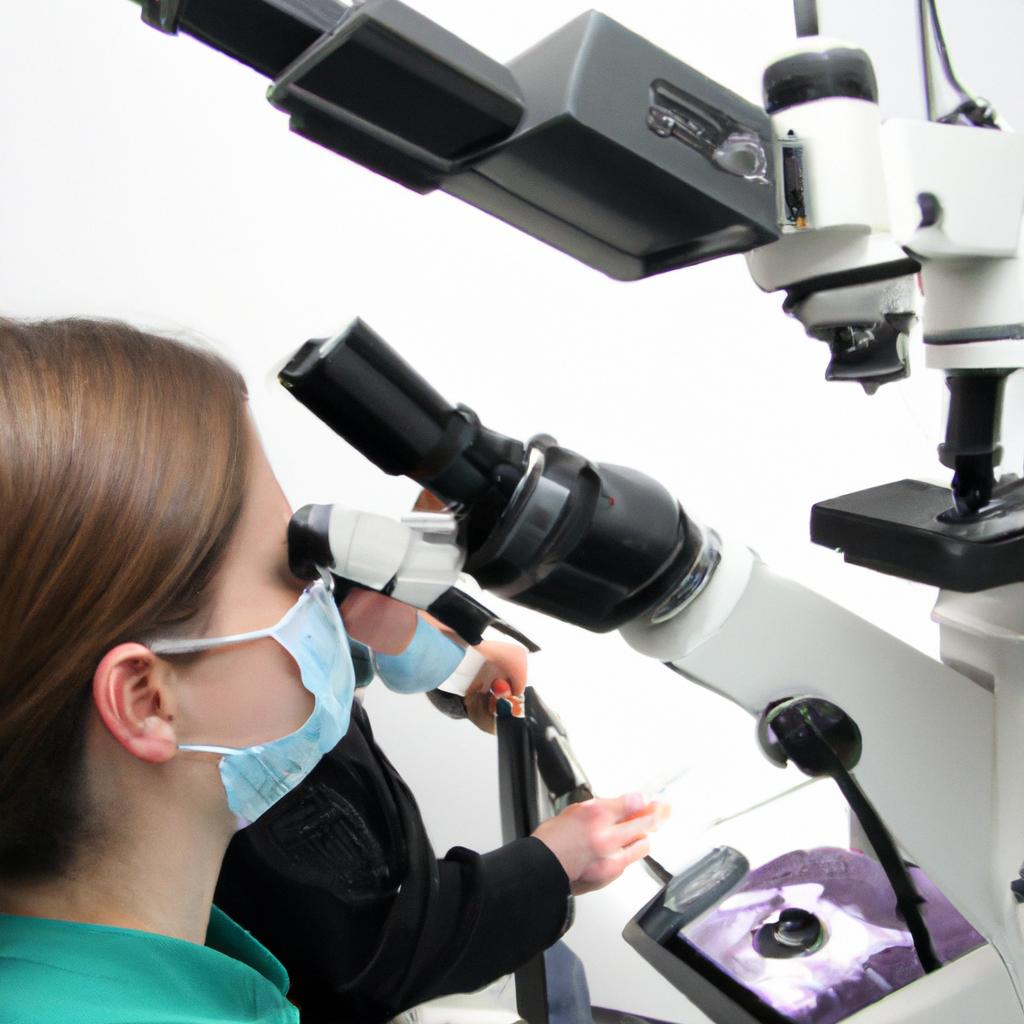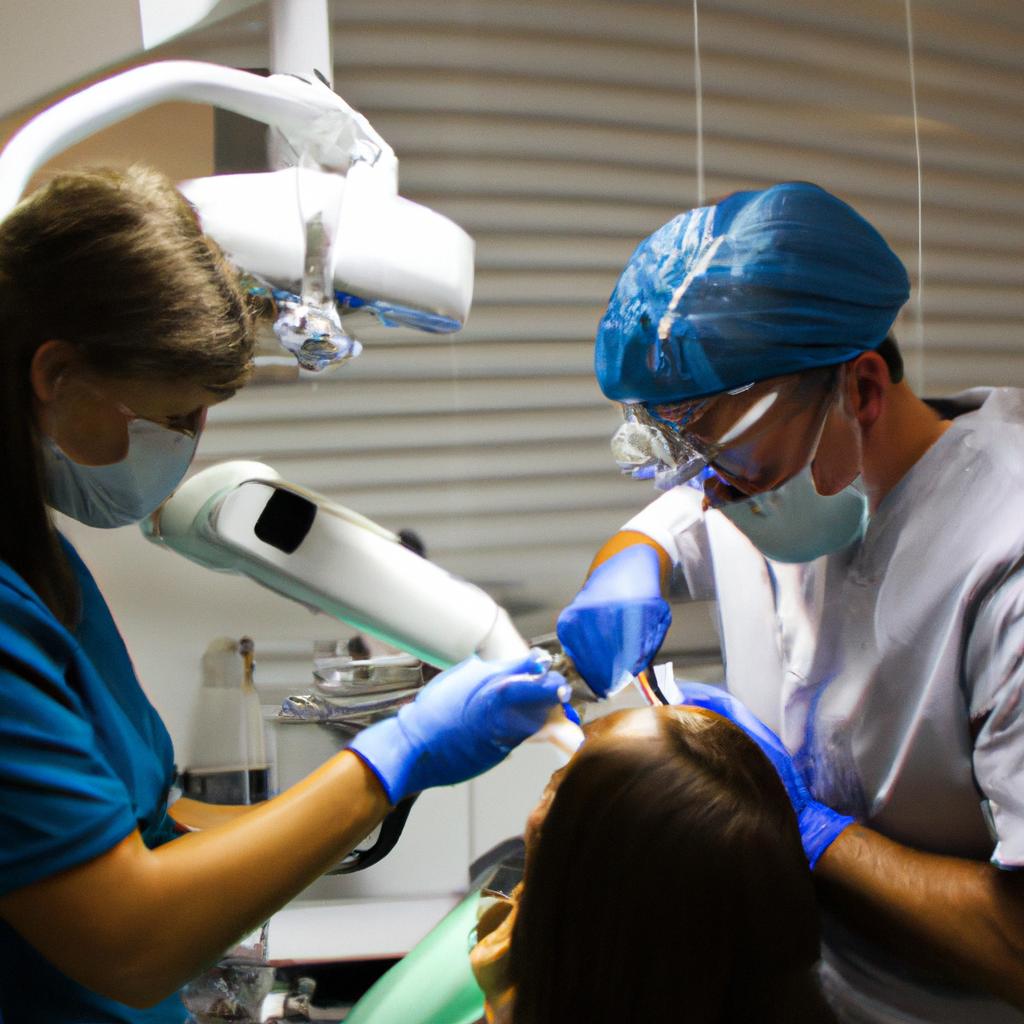Vital Pulp Therapy in Endodontics: A Crucial Approach
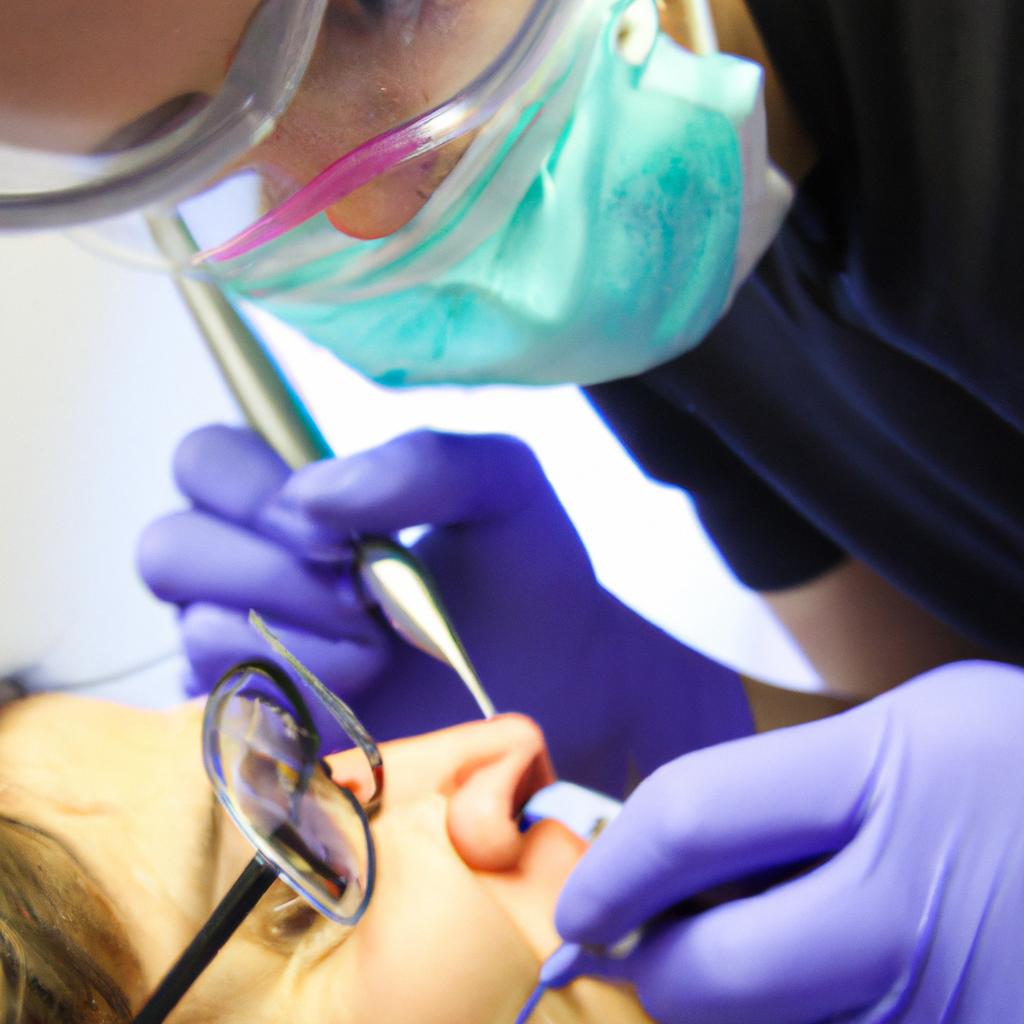
Vital pulp therapy in endodontics is a crucial approach that aims to preserve the vitality and functionality of dental pulps affected by irreversible inflammation or infection. This treatment modality has gained significant attention in recent years due to its potential benefits, such as promoting healing and reducing the need for more invasive procedures like root canal therapy or tooth extraction. For instance, consider the case of a 35-year-old patient who presented with severe pain in their lower molar caused by deep caries. Through vital pulp therapy techniques, it was possible to alleviate the symptoms, restore tissue health, and avoid further damage to the tooth structure.
In traditional endodontic practices, the conventional treatment for inflamed or infected dental pulps involves complete removal via root canal therapy. However, this technique may compromise tooth integrity and function over time. Vital pulp therapy offers an alternative strategy that focuses on preserving viable pulpal tissues whenever feasible. By removing only the diseased portions while maintaining healthy pulp structures intact, clinicians can promote tissue regeneration and prolong natural dentition life expectancy. Furthermore, vital pulp therapy provides patients with an opportunity to retain their natural teeth rather than resorting to prosthetic replacements or implants, thus contributing positively to oral health outcomes and overall quality of life.
Definition of vital pulp therapy
Definition of Vital Pulp Therapy
Vital pulp therapy, a crucial approach in endodontics, aims to preserve the vitality and functionality of the dental pulp when it has been compromised by injury or disease. It involves various techniques that promote healing and regeneration within the affected tooth, allowing for continued natural function. To better understand this concept, let us consider an example:
Imagine a patient who presents with deep caries affecting the dentin but not yet reaching the pulp chamber. In such cases, vital pulp therapy can be employed as an alternative to root canal treatment. By removing only the infected dentin and applying appropriate biomaterials directly over the exposed area, we can stimulate reparative dentinogenesis and encourage the preservation of healthy pulpal tissue.
To highlight the significance of vital pulp therapy, here are four key points worth considering:
- Preservation of Natural Tooth Structure: Vital pulp therapy focuses on maintaining as much natural tooth structure as possible while treating diseased or injured teeth.
- Promotion of Dentinal Bridge Formation: One major objective is to stimulate reparative processes within the dental pulp, leading to the formation of a protective layer called a dentinal bridge.
- Elimination of Pain and Discomfort: By addressing early stages of pulpal inflammation or infection through vital pulp therapy, patients can experience relief from pain and discomfort associated with more extensive treatments.
- Enhanced Long-term Prognosis: Preserving healthy pulpal tissue allows for improved long-term prognosis compared to conventional root canal treatment.
To further illustrate these aspects visually, please refer to Table 1 below:
| Key Points | Advantages | Benefits |
|---|---|---|
| Preservation | Retains natural tooth structure | Reduces risk of complications |
| Dentinal Bridge Formation | Stimulates reparative dentinogenesis | Reinforces structural integrity |
| Pain Elimination | Alleviates pain and discomfort | Enhances patient comfort |
| Long-term Prognosis | Improves long-term prognosis of the tooth | Preserves natural dentition functionality |
In summary, vital pulp therapy serves as a valuable treatment approach in endodontics by preserving the integrity of dental pulpal tissue. By maximizing the retention of natural tooth structure, promoting reparative processes, relieving pain, and enhancing overall long-term prognosis, this technique offers several advantages for both patients and clinicians.
Moving forward into the subsequent section on “Indications for Vital Pulp Therapy,” we will explore when such procedures are appropriate based on specific clinical situations.
Indications for vital pulp therapy
Vital Pulp Therapy: Indications and Considerations
Case Study:
Imagine a patient, Sarah, who presents with deep caries in her mandibular first molar. The tooth is asymptomatic but exhibits reversible pulpal inflammation upon examination. In such cases, vital pulp therapy (VPT) becomes an invaluable treatment approach to preserve the vitality of the dental pulp while preventing further damage. Understanding the indications for VPT is crucial for clinicians when deciding on the most appropriate management strategy.
Indications for Vital Pulp Therapy:
- Deep Carious Lesions: When a cavity extends close to or invades the pulp chamber, it poses a risk of irreversible pulpitis or even necrosis if left untreated. However, if diagnosed early and managed promptly, VPT can prevent these complications.
- Traumatic Dental Injuries: Teeth affected by trauma may exhibit various degrees of pulpal involvement. For example, a luxated tooth could result in partial dislodgement without complete root fracture or avulsion. In such cases, VPT can aid in preserving the vitality of the pulp and promoting healing.
- Immature Permanent Teeth with Apical Periodontitis: In young patients with immature permanent teeth suffering from apical periodontitis due to bacterial contamination through open apexes, VPT offers an opportunity for continued root development and resolution of periapical lesions.
- Reversible Pulpitis: Pulpal inflammation caused by stimuli like caries progression or restorative procedures can be reversed with timely intervention using VPT techniques.
Table – Common Indications for Vital Pulp Therapy:
| Indication | Description |
|---|---|
| Deep Carious Lesions | Extensive cavities that pose a risk of irreversible pulpitis or necrosis |
| Traumatic Dental Injuries | Partial dislodgement or non-avulsed teeth affected by traumatic incidents |
| Immature Permanent Teeth with Apical Periodontitis | Open apexes in immature permanent teeth leading to apical periodontitis |
| Reversible Pulpitis | Inflammation caused by stimuli that can be reversed with timely VPT intervention |
By recognizing these indications, clinicians can make informed decisions regarding the most appropriate treatment modality. However, it is important to note that not all cases are suitable for vital pulp therapy, and careful patient selection and assessment of clinical factors are essential.
Moving forward, understanding the benefits of vital pulp therapy will shed light on why this approach holds a crucial position in endodontic practice. The subsequent section will explore these advantages and how they contribute to successful outcomes.
Benefits of vital pulp therapy
Indications for Vital Pulp Therapy: Safeguarding Dental Health
To comprehend the significance of vital pulp therapy in endodontics, it is crucial to explore its indications. By identifying these indications, dental professionals can effectively determine when this approach should be employed to preserve dental health and ensure optimal patient outcomes.
One illustrative example of an indication for vital pulp therapy involves a case where a young adult presents with deep caries extending close to the pulp chamber but without any signs of irreversible pulpitis or apical pathology. In such cases, vital pulp therapy can serve as a viable treatment option to prevent further damage and maintain tooth vitality.
There are several key indications that warrant the consideration of vital pulp therapy:
- Presence of deep caries reaching close proximity to the pulp chamber.
- Absence of irreversible inflammation or infection within the pulpal tissues.
- Intact dentin barrier providing protection against bacterial penetration into the pulp.
- Adequate remaining tooth structure allowing for restoration and functional longevity.
These indicators highlight the importance of early diagnosis and intervention, emphasizing the role of vital pulp therapy in preserving natural dentition while avoiding more invasive treatments like root canal procedures or extractions.
To better understand the distinctions between different treatment modalities, consider the following table:
| Treatment Modality | Advantages | Disadvantages |
|---|---|---|
| Vital Pulp Therapy | Preserves tooth vitality | Limited success in some cases |
| Root Canal Treatment | Eliminates source of infection | Weakening of tooth structure |
| Tooth Extraction | Complete removal of affected tooth | Loss of natural dentition |
This comparison highlights how vital pulp therapy stands out as a conservative approach that aims to retain healthy tissue whenever possible.
In light of these considerations, exploring various techniques used in vital pulp therapy becomes imperative. Transitioning seamlessly into our next section, we will delve into the different techniques employed to effectively carry out this crucial dental procedure.
Different techniques of vital pulp therapy
Case Study:
Consider a scenario where a patient presents with irreversible pulpitis, characterized by severe dental pain and inflammation. The traditional approach would involve root canal treatment to eliminate the infected pulp tissue. However, vital pulp therapy offers an alternative solution that aims to preserve the vitality and function of the remaining healthy pulpal tissue.
Different techniques have been developed for performing vital pulp therapy, each tailored to specific clinical scenarios. These techniques can be classified into two main categories: indirect pulp capping and direct pulp capping/pulpotomy.
Indirect pulp capping involves placing a biocompatible material over the partially exposed or carious dentin to stimulate reparative dentin formation and protect the underlying pulp from further damage. This technique is typically employed when there is minimal pulpal involvement or in cases where complete removal of affected dentin is not feasible due to proximity to the pulp.
On the other hand, direct pulp capping or pulpotomy entails directly treating the exposed or inflamed pulp tissue. Direct pulp capping involves applying a suitable medicament such as calcium hydroxide or mineral trioxide aggregate (MTA) onto the exposed pulp, followed by placement of a protective restoration. Pulpotomy involves partial removal of the inflamed coronal portion of the pulp, aiming to retain healthy radicular tissue.
To illustrate further, let us examine some key benefits associated with different techniques of vital pulp therapy:
- Preservation of natural tooth structure
- Promotion of continued root development in young permanent teeth
- Maintenance of pulpal blood supply and neurovascularity
- Reduction in postoperative complications
The following table provides an overview comparing indirect and direct approaches in terms of indications, materials used, success rates, and potential risks:
| Technique | Indications | Materials Used | Success Rates |
|---|---|---|---|
| Indirect pulp capping | Minimal pulpal involvement | Calcium hydroxide, MTA | 85-95% |
| Carious dentin near the pulp | |||
| Direct pulp capping | Exposed or inflamed pulp tissue | Calcium hydroxide, MTA | 70-90% |
| Pulpotomy | Inflamed coronal portion of pulp | Formocresol, MTA | 80-90% |
It is important to note that success rates may vary depending on several factors such as patient age, tooth type, and operator skill. Therefore, careful case selection and appropriate technique application are crucial for achieving favorable outcomes.
Transitioning into the subsequent section about “Success Rates and Long-Term Outcomes,” it becomes imperative to evaluate the effectiveness and durability of vital pulp therapy techniques. By assessing long-term follow-up studies and evaluating clinical data, a comprehensive understanding of these aspects can be obtained.
Success rates and long-term outcomes
Vital Pulp Therapy in Endodontics: A Crucial Approach
Different Techniques of Vital Pulp Therapy
In the previous section, we explored the various techniques utilized in vital pulp therapy. Now, let us delve further into the success rates and long-term outcomes associated with this crucial approach.
To illustrate the effectiveness of vital pulp therapy, consider a hypothetical case study involving a patient presenting with irreversible pulpitis in a mandibular molar. The dentist decides to perform direct pulp capping as part of the treatment plan. After successful disinfection and isolation, a biocompatible material is applied directly onto the exposed pulp tissue. Over time, dentin bridge formation occurs, effectively sealing off any potential microbial ingress and promoting continued pulpal healing.
When considering the overall success rates and long-term outcomes of vital pulp therapy, several key factors come into play:
- Timing: Early intervention plays a pivotal role in preserving dental vitality. Prompt diagnosis and immediate application of appropriate vital pulp therapy techniques can significantly improve treatment outcomes.
- Patient age: Younger patients tend to exhibit higher success rates due to their increased regenerative capacity compared to older individuals.
- Preoperative status: An accurate assessment of pulpal health prior to intervention guides clinicians in implementing suitable strategies for optimal results.
- Operator expertise: Skilled practitioners who adhere to best clinical practices are more likely to achieve favorable outcomes through meticulous technique execution.
Table 1 below summarizes some reported success rates related to different forms of vital pulp therapy:
| Technique | Success Rate |
|---|---|
| Direct Pulp Capping | 75-90% |
| Partial Pulpotomy | 85-95% |
| Indirect Pulp Capping | 80-95% |
| Regenerative Endodontics | Up to 85% |
It is important to note that while these figures provide valuable insights into the efficacy of vital pulp therapy, individual case variations and factors not mentioned here may influence these outcomes.
In consideration of the success rates and long-term outcomes discussed thus far, it becomes evident that vital pulp therapy is a promising approach in endodontics. In our subsequent section on “Considerations and Limitations of Vital Pulp Therapy,” we will explore further aspects that clinicians must bear in mind when implementing this treatment modality to ensure its optimal effectiveness.
[Transition Sentence]
Considerations and limitations of vital pulp therapy will be examined in detail in the next section to provide a comprehensive understanding of this crucial endodontic technique.
Considerations and limitations of vital pulp therapy
Transitioning from the discussion on success rates and long-term outcomes, it is important to consider the various considerations and limitations associated with vital pulp therapy in endodontics. While this approach has shown promising results, there are certain factors that need to be taken into account for its effective implementation.
To illustrate these considerations, let us delve into a hypothetical case study. Imagine a patient presenting with irreversible pulpitis in a mandibular molar exhibiting moderate symptoms such as lingering pain upon thermal stimuli. The clinician decides to perform vital pulp therapy as an alternative to conventional root canal treatment due to its potential benefits. However, before proceeding, several key aspects must be evaluated.
Firstly, the extent of pulpal inflammation should be carefully assessed. Vital pulp therapy is generally more successful when performed in cases where the inflammation is localized and not extensive. This highlights the importance of accurate diagnosis through clinical examination and radiographic evaluation to determine if a tooth is suitable for this approach.
Secondly, it is crucial to evaluate the prognosis based on individual patient factors. Factors such as age, medical history, oral hygiene practices, and compliance play a significant role in determining the success of vital pulp therapy. A comprehensive assessment of these factors allows clinicians to identify patients who are likely to benefit from this conservative treatment option.
Thirdly, material selection plays a pivotal role in achieving favorable outcomes. Various materials have been used in vital pulp therapy including calcium hydroxide-based liners and bioceramic materials. Each material possesses unique properties that influence their biocompatibility and sealing ability within the dental pulp environment.
Considering these considerations and limitations associated with vital pulp therapy can help maximize its effectiveness while minimizing risks or complications:
- Accurate diagnosis of pulpal inflammation.
- Comprehensive evaluation of patient-related prognostic factors.
- Proper material selection based on scientific evidence.
- Regular monitoring and follow-up protocols after the procedure.
To summarize, vital pulp therapy is a valuable approach in endodontics. However, its successful implementation requires careful consideration of factors such as pulpal inflammation extent, patient-related prognostic factors, appropriate material selection, and diligent follow-up procedures. By addressing these considerations, clinicians can enhance their decision-making process and provide optimal care to patients requiring this crucial treatment modality.
| Considerations/Limitations | Importance |
|---|---|
| Pulpal Inflammation Extent | High |
| Patient-Related Prognostic Factors | Medium |
| Material Selection | Medium |
| Follow-Up Protocols | Low |
In conclusion, by acknowledging the limitations and considering specific aspects associated with vital pulp therapy, dental professionals can increase the likelihood of successful outcomes for their patients. This enables them to offer an effective alternative that preserves pulp vitality while ensuring long-term oral health.

